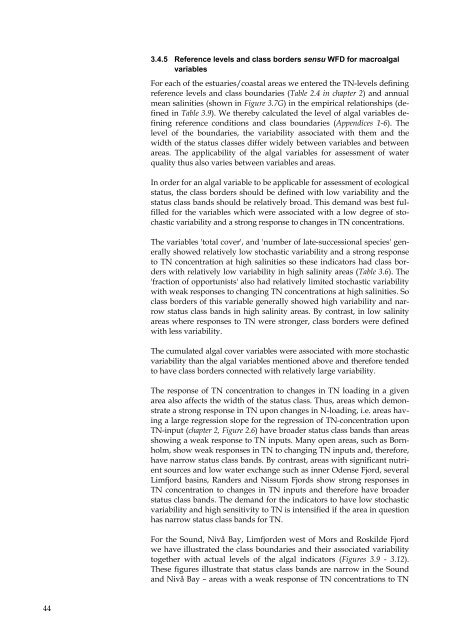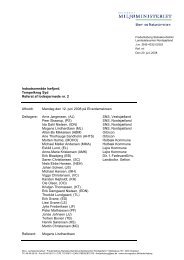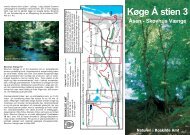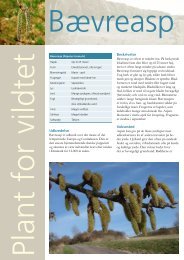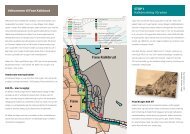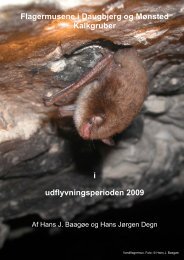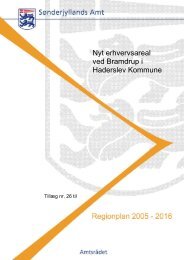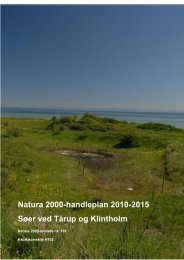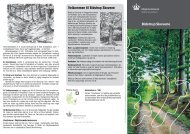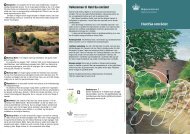Macroalgae and phytoplankton as indicators of ... - Naturstyrelsen
Macroalgae and phytoplankton as indicators of ... - Naturstyrelsen
Macroalgae and phytoplankton as indicators of ... - Naturstyrelsen
You also want an ePaper? Increase the reach of your titles
YUMPU automatically turns print PDFs into web optimized ePapers that Google loves.
3.4.5 Reference levels <strong>and</strong> cl<strong>as</strong>s borders sensu WFD for macroalgal<br />
variables<br />
For each <strong>of</strong> the estuaries/co<strong>as</strong>tal are<strong>as</strong> we entered the TN-levels defining<br />
reference levels <strong>and</strong> cl<strong>as</strong>s boundaries (Table 2.4 in chapter 2) <strong>and</strong> annual<br />
mean salinities (shown in Figure 3.7G) in the empirical relationships (defined<br />
in Table 3.9). We thereby calculated the level <strong>of</strong> algal variables defining<br />
reference conditions <strong>and</strong> cl<strong>as</strong>s boundaries (Appendices 1-6). The<br />
level <strong>of</strong> the boundaries, the variability <strong>as</strong>sociated with them <strong>and</strong> the<br />
width <strong>of</strong> the status cl<strong>as</strong>ses differ widely between variables <strong>and</strong> between<br />
are<strong>as</strong>. The applicability <strong>of</strong> the algal variables for <strong>as</strong>sessment <strong>of</strong> water<br />
quality thus also varies between variables <strong>and</strong> are<strong>as</strong>.<br />
In order for an algal variable to be applicable for <strong>as</strong>sessment <strong>of</strong> ecological<br />
status, the cl<strong>as</strong>s borders should be defined with low variability <strong>and</strong> the<br />
status cl<strong>as</strong>s b<strong>and</strong>s should be relatively broad. This dem<strong>and</strong> w<strong>as</strong> best fulfilled<br />
for the variables which were <strong>as</strong>sociated with a low degree <strong>of</strong> stoch<strong>as</strong>tic<br />
variability <strong>and</strong> a strong response to changes in TN concentrations.<br />
The variables 'total cover', <strong>and</strong> 'number <strong>of</strong> late-successional species' generally<br />
showed relatively low stoch<strong>as</strong>tic variability <strong>and</strong> a strong response<br />
to TN concentration at high salinities so these <strong>indicators</strong> had cl<strong>as</strong>s borders<br />
with relatively low variability in high salinity are<strong>as</strong> (Table 3.6). The<br />
'fraction <strong>of</strong> opportunists' also had relatively limited stoch<strong>as</strong>tic variability<br />
with weak responses to changing TN concentrations at high salinities. So<br />
cl<strong>as</strong>s borders <strong>of</strong> this variable generally showed high variability <strong>and</strong> narrow<br />
status cl<strong>as</strong>s b<strong>and</strong>s in high salinity are<strong>as</strong>. By contr<strong>as</strong>t, in low salinity<br />
are<strong>as</strong> where responses to TN were stronger, cl<strong>as</strong>s borders were defined<br />
with less variability.<br />
The cumulated algal cover variables were <strong>as</strong>sociated with more stoch<strong>as</strong>tic<br />
variability than the algal variables mentioned above <strong>and</strong> therefore tended<br />
to have cl<strong>as</strong>s borders connected with relatively large variability.<br />
The response <strong>of</strong> TN concentration to changes in TN loading in a given<br />
area also affects the width <strong>of</strong> the status cl<strong>as</strong>s. Thus, are<strong>as</strong> which demonstrate<br />
a strong response in TN upon changes in N-loading, i.e. are<strong>as</strong> having<br />
a large regression slope for the regression <strong>of</strong> TN-concentration upon<br />
TN-input (chapter 2, Figure 2.6) have broader status cl<strong>as</strong>s b<strong>and</strong>s than are<strong>as</strong><br />
showing a weak response to TN inputs. Many open are<strong>as</strong>, such <strong>as</strong> Bornholm,<br />
show weak responses in TN to changing TN inputs <strong>and</strong>, therefore,<br />
have narrow status cl<strong>as</strong>s b<strong>and</strong>s. By contr<strong>as</strong>t, are<strong>as</strong> with significant nutrient<br />
sources <strong>and</strong> low water exchange such <strong>as</strong> inner Odense Fjord, several<br />
Limfjord b<strong>as</strong>ins, R<strong>and</strong>ers <strong>and</strong> Nissum Fjords show strong responses in<br />
TN concentration to changes in TN inputs <strong>and</strong> therefore have broader<br />
status cl<strong>as</strong>s b<strong>and</strong>s. The dem<strong>and</strong> for the <strong>indicators</strong> to have low stoch<strong>as</strong>tic<br />
variability <strong>and</strong> high sensitivity to TN is intensified if the area in question<br />
h<strong>as</strong> narrow status cl<strong>as</strong>s b<strong>and</strong>s for TN.<br />
For the Sound, Nivå Bay, Limfjorden west <strong>of</strong> Mors <strong>and</strong> Roskilde Fjord<br />
we have illustrated the cl<strong>as</strong>s boundaries <strong>and</strong> their <strong>as</strong>sociated variability<br />
together with actual levels <strong>of</strong> the algal <strong>indicators</strong> (Figures 3.9 - 3.12).<br />
These figures illustrate that status cl<strong>as</strong>s b<strong>and</strong>s are narrow in the Sound<br />
<strong>and</strong> Nivå Bay – are<strong>as</strong> with a weak response <strong>of</strong> TN concentrations to TN<br />
44


